Canon EF 24-70 mm f/4L IS USM
3. Build quality and image stabilization
When it comes to rivals produced by other companies, you have to admit there are not many of them. Those lenses which have a bit similar focal range and aperture are shown in the following chart. A comparison makes sense only if you choose a newer construction so the Nikkor and the Sony, designed for full frame mirrorless cameras. The Sony, when compared to the Canon tested here, seems like a simple ‘kit’ lens – it is smaller, physically lighter, optically simpler, with an inferior minimum focusing distance and a lower number of diaphragm blades.
In the photo below the Canon EF 24–70 mm f/4L IS USM is positioned near the Nikkor AF-S 16-35 mm f/4G ED VR and the Canon EF 85 mm f/1.8 USM.
Please Support UsIf you enjoy our reviews and articles, and you want us to continue our work please, support our website by donating through PayPal. The funds are going to be used for paying our editorial team, renting servers, and equipping our testing studio; only that way we will be able to continue providing you interesting content for free. |
- - - - - - - - - - - - - - - - - - - - - - - - - - - - - - - - - - - - - - - - - - - - - - - -
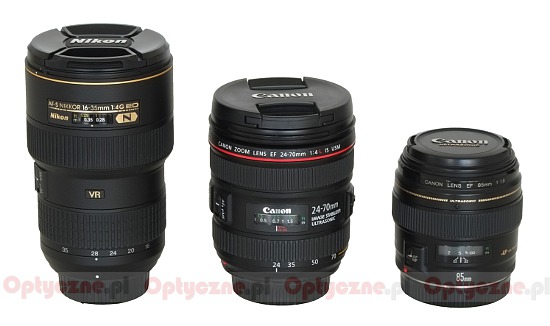 |
The tested lens starts with a metal mount surrounding a contact plate and a rear element, 23 mm in diameter. The rear element is situated on the same level as the contacts at 24 mm focal length. When you pass to 70 mm the element hides inside almost 2.5 cm deep, revealing side parts of the tube. They don’t look too good - not everything is blackened properly, some of them are simply shiny. Still it should be noticed that on the edge of the proper casing (where it sticks to a camera body) there is a rubber gasket.
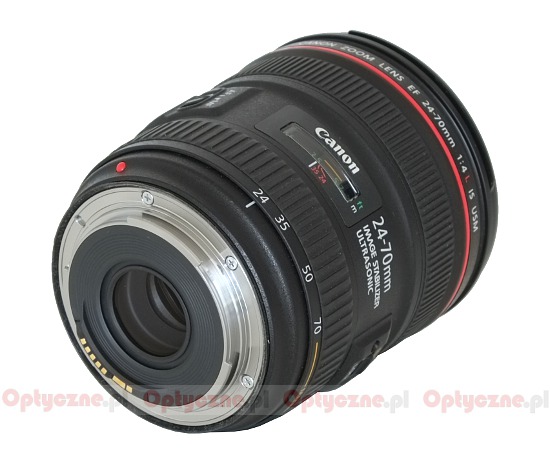 |
The casing of the lens starts with a black immobile ring made of metal. The bigger the distance from the mount the wider it becomes and it features a red dot, making the alignment with a camera easier.
A zoom ring, almost 20 mm wide, is the next part of the lens. Most of its surface is covered by rubber ribs and below you can find focal length markings at 24, 35, 50 and 70 mm. The rings moves evenly and is well-damped, supporting the whole construction so well that even vigorous shaking doesn’t cause any zoom creep and/or focal length change.
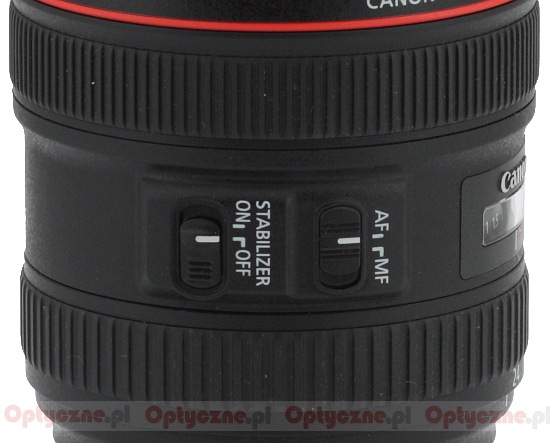 |
Further on you see a distance scale window, with the scale expressed in feet and metres. Below, there are infinity markings for infrared photography (at 24 and 35 mm focal lengths). On the left there is a focusing mechanism mode switch (AF/MF) and a stabilization switch (STABILIZER ON/OF); on the right there is a LOCK/MACRO button, which in one position allows you to block the focal length and in the other – switches on the macro mode. That mode is available after turning the zoom ring past 70 mm; then it is possible to set focus already from 8 cm from the front element. On the side opposite to the distance scale of the lens there is its serial number and information that it was produced in Japan.
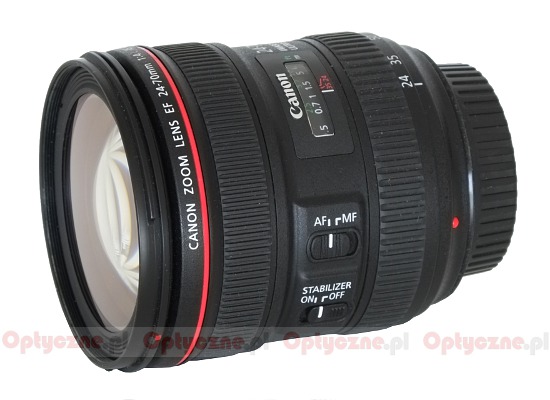 |
A manual focus ring is the next part of the lens. It is 19 mm wide and most of it is covered by rubber armour with ribs. Its performance is flawless and precise, running through the whole distance scale takes a turn through an angle of 110 degrees. The ring is a so-called full time manual (FTM), working both in the MF and the AF mode.
The front element is 62 mm in diameter and surrounded by a 77 mm filter thread which does not rotate and a hood mount. When you pass toward the 70 mm focal length the whole front element system extends on a solid, one-part tube and the whole lens becomes longer by about three centimeters.
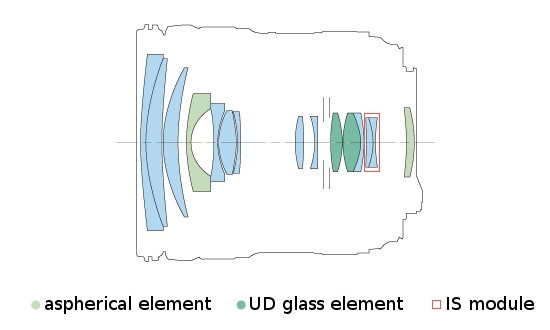 |
When it comes to the optical construction you deal here with 15 elements positioned in 12 groups. Two elements are made of low dispersion UD glass and two others are aspherical. Inside, you can also find a round aperture with nine diaphragm blades which can be closed down to f/22.
Buyers get both caps, a petal-type hood and a soft pouch in the box.
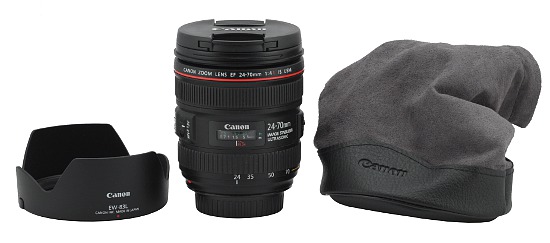 |
Image stabilization
Our optical stabilization test was conducted at 70 mm; we took several dozen photos for every shutter speed ranging from 1/80 to 1/2 of a second with the stabilization switched on and off. The graph below shows a percentage of blurred photos in correlation with the shutter speed expressed in EV and 0 EV is an equivalent of 1/60 of a second.
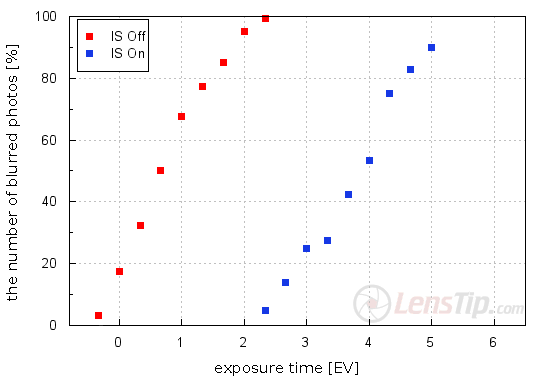
As you can notice the maximum distance between both curves amounts to 3.3 EV and so we assess the efficiency of the stabilization featured by the tested lens. It is a good result but not the best - currently the most efficient L-series Canon products can reach over 4 EV.






